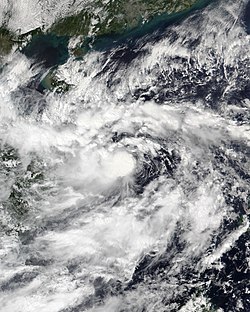This article's factual accuracy is disputed .(April 2022) |
 Tropical Storm Linfa approaching Vietnam on October 11 | |
| Meteorological history | |
|---|---|
| Formed | October 6,2020 |
| Dissipated | October 12,2020 |
| Tropical storm | |
| 10-minute sustained (JMA) | |
| Highest winds | 75 km/h (45 mph) |
| Lowest pressure | 994 hPa (mbar);29.35 inHg |
| Tropical storm | |
| 1-minute sustained (SSHWS/JTWC) | |
| Highest winds | 75 km/h (45 mph) |
| Lowest pressure | 999 hPa (mbar);29.50 inHg |
| Overall effects | |
| Fatalities | 138 |
| Missing | 27 |
| Damage | $217 million (2020 USD) |
| Areas affected | Philippines,Vietnam,Cambodia,Laos,Thailand,Myanmar |
| IBTrACS / [1] | |
Part of the 2020 Pacific typhoon season | |
Tropical Storm Linfa was a weak,short-lived but deadly and destructive tropical cyclone that was the twelfth wettest tropical cyclone on record and the second of nine tropical cyclones in a row to strike Indochina in 2020,a little under a month after the less damaging Tropical Storm Noul. The fifteenth named storm of the 2020 Pacific typhoon season,Linfa originated from a tropical depression which formed just to the west of the Philippines on October 6. After passing through the island nation,the storm emerged into the South China Sea and slowly gained strength,earning the name Linfa on October 10 on approach to Vietnam. On the next day,Linfa had reached peak strength and made landfall in Vietnam,marking the beginning of a devastating series of floods in the country and worsening the already active monsoon season. Linfa quickly dissipated as it moved inland,but associated thunderstorms continued for several days.
Contents
- Meteorological history
- Preparations and impact
- Philippines
- Vietnam
- Other regions
- Aftermath
- Retirement
- See also
- References
- External links
Linfa brought record breaking rainfall totals throughout much of the Indochinese Peninsula. 112 people were left dead in Vietnam,with 24 missing. An additional 25 people died in Cambodia and there was 1 killed in Laos with 3 missing. Damage totals throughout Vietnam reached up to US$217 million,or 4.9 trillion đồng. Linfa was also the second-deadliest storm of 2020,closely behind Hurricane Eta and the deadliest of the annual typhoon season.


